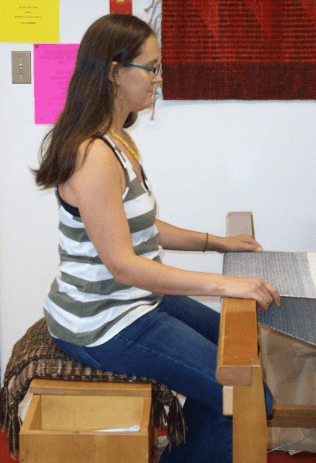This post was written by Laura Fry for Academy members. Find more of Laura Fry’s weaving and works on her blog, Weaving a Life.
Handwoven cloth is, by its very definition, slow.
That doesn’t mean it can’t be done efficiently. Ergonomically.
What’s the difference? According to some dictionaries, there isn’t a difference, but for me ergonomics means working *with* your body which generally results in higher efficiency.
So, let’s break that down.

Our bodies are made up of joints (skeleton) and soft tissues (muscles, ligaments and so on). As such there are ways that our bodies are able and willing to bend, and ways that they would rather not. When we practice a craft like hand weaving, it helps to remember that when we work in co-operation with our body, and how it works ‘best’, things will go a lot more smoothly for us.
Not every body is the same as everybody else, and some of us come to the craft of weaving with pre-existing conditions (injuries, habits). Part of learning how to weave more ergonomically/efficiently is to understand what happens when we do repetitive motions and why we need to take breaks and nurture our soft tissues.
Other considerations are things like our handedness – if we are best working with a dominant right or left hand, or the lucky few who have equal facility with either.
Our vision – is it good or not? Do we need corrective lenses? Do we have progressive lenses? Do we have good depth perception? Peripheral vision?
When we work in a craft that is as labour intensive as hand weaving, it’s a good idea to take a bit of an inventory of our positive and negative attributes. How flexible are we? How much fitness do we have?
How do we best learn?
One of my challenges as a teacher is to try and figure out ways to help people understand what is happening and why they might like to try something different. Or, if they can’t do it ‘my’ way, what is a good way for them to work?
Not everyone is built like me – tall, good proportions between upper and lower body, long(ish) arms. They may not have the level of proprioception I have (high level of body awareness and how one’s body interacts with their environment, tools and so on).
They may not be used to being coached or have an awareness of how minor changes might bring large rewards. They might feel that, as an adult, they ought to be able to pick up a new physical skill immediately, forgetting that acquiring a skill requires practicing until it becomes part of one’s skill set.
I came to weaving as a reasonably fit person, well used to being coached (music, ballet, track and field, etc.) and proprioception. When I began weaving in earnest, in the quiet of my own studio, I was able to focus on what I was doing and when something felt awkward, begin to make small changes.
Fortunately I had had a good instructor who gave good information on things like posture and position at the loom, and so I began by working on those. As I wove more, paid attention more, tweaked more, I noticed a decided increase in my productivity.
At no point in the process was I ‘hurrying’ – just slowly and steadily removing excess movement from the processes.
Sitting at the loom throwing the shuttle became a working meditation for me and I still enjoy the process of heading to the loom and weaving. It has become a time for me to set the cares and worries of the world aside and stay in the moment as I open the shed, throw the shuttle, beat, repeat. All while paying attention to my hand motions and the force I apply to the weft.
This was not something I acquired quickly, but with time, attention and constant awareness, I became very productive.
If you are new to weaving, you might want to do a little self-check.
Let’s begin with how you sit at the loom.
Each loom brand/model is different and may ‘fit’ one person better than another. If you are of short stature, you may not feel comfortable at a loom that a larger person finds suitable. It may be too tall, or too long a distance from breast beam to shafts. If you are a taller person, you may feel cramped at a loom that is lower to the ground with little room under the breast beam for your legs. All looms are not the same, just like not all people are the same.
The best approach is to try weaving on a loom before purchasing but if that isn’t possible, talk to others about your same height, arm/leg length, find out which brands/models of loom they find comfortable.
Having a bench, chair or stool of the correct height for you at your loom is essential. There are very few looms where sitting on an ‘ordinary’ chair is good for your body.

You should be sitting with your hips higher than your knees, with elbows able to clear the breast beam without hunching your shoulders upwards. Sitting is more like perching on the edge of the seat, allowing the legs full range of movement to treadle. Try to ensure that you are sitting on your sitz bones not your coccyx. That means a pelvic tilt to get the body up onto the sitz bones.
This position will tend to tilt your body slightly forward so your abdominal muscles should be activated to help keep you in this position, your back should be straight, shoulders in neutral, upper back not hunched.
The image above shows good posture (should be a little bit more forward – legs are still too much on the loom bench) back is straight, shoulders are in neutral. Note that elbows are higher than the breast beam.

In the second photo, the weavers pelvis is rotated so that she is sitting on her coccyx (tailbone), her back is not straight, and her shoulders are slumped. Her elbows are now the same height as the breast beam.
Sometimes the bench is fine, it’s the posture that needs to be adjusted.
During weaving, motions should flow one into the other – open shed, throw shuttle, beat weft into place while changing shed, repeat.
The motion begins with leaning forward by bending at the hips (abdominals engaged), placing the shuttle in position to ‘throw’, catching it on the other side of the warp, bringing the beater forward by bending at the hips and leaning slightly backwards and while the centre of gravity is over the sitz bones, changing the shed as the beater goes back to the castle, slightly leaning forward. Keeping the abdominal muscles engaged at all times will protect your lower back.
